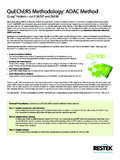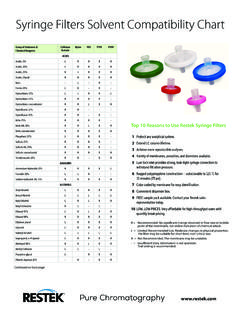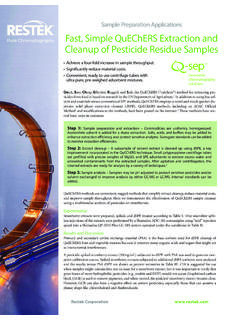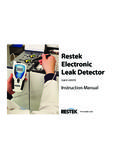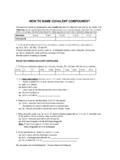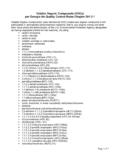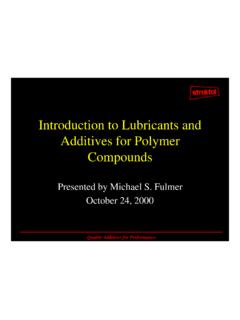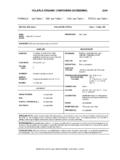Transcription of Pharmaceutical Applications How Column …
1 Restek Corporation all Column deactivations are appropriate for analyzing basic compounds. Here we demonstrate the effect of Column inertness on peak shape, and discuss its role in improving method accuracy, sensitivity, and development compounds are often problematic to analyze by gas chromatography. Poor peak symmetry, or tail-ing, is common and can lead to inconsistent integration and calibrations, as well as losses in sensitivity, due to lower signal-to-noise ratios. In both GC and LC alike, peak tailing of basic compounds can be largely attributed to silanol activity, through an adsorption mechanism where the solutes interact with the exposed silica support in LC or the fused silica capillary in GC. In LC, we have the option of modifying our mobile phase with additives, like triethylamine (TEA), that can act to limit the unwanted silanol inter-action. In GC, however, we do not have this option and this puts greater importance on choosing an inert Column , such as an Rxi Column , which has a balanced deactivation that is effective toward both basic and acidic compounds.
2 In this article we will discuss the relationship between inertness and system activity, illustrate the effect of improper Column deactivation with an example for basic compounds, and discuss options for improving peak Inertness in Gas ChromatographyGlass and metal surfaces are chemically reactive and can undergo solute adsorption, which manifests as chromatographic peak tailing. The entire sample pathway, which includes the liner and the chromato-graphic Column , needs to be inert. Deactivation is simply a means by which Column manufacturers treat the sample pathway to eliminate unwanted chemical interaction, which may be more practically viewed as imparting inertness. Capillary Column deactivation involves treating the fused silica and creating poly-mers that limit the residual silanol activity that is the basis for the tailing of basic compounds. Not all deac-tivation processes are the same, however, and most are tailored to specific solute characteristics. Every manufacturer defines a chemical process, or deactivation technology, for deactivating their capillary columns and liners, and this may vary by Column line and System ActivityThe tailing of basic compounds is certainly familiar to the Pharmaceutical researcher as amines are com-monly found on active Pharmaceutical ingredients and impurities.
3 When troubleshooting our chro-matography, improper Column deactivation can be easily diagnosed. Peak tailing as a result of solute adsorption is mass dependent. As mass (sample load) increases, tailing becomes less prominent. The ZB-624 Column tested in Figure 1 illustrates this point. As the isopropylamine mass on- Column drops, tailing Pharmaceutical ApplicationsHow Column Inertness Improves the Chromatography of Basic CompoundsChromatography ProductsGC_PH1164GC_PH1163ZB-624 Integration not possible below 25 ngRxi -624 Sil MS5-100 ng on- Column ,R2 = peak symmetryand retention time stability result in high sensitivity andlinearity on the Rxi -624 Sil MSColumn Rxi -624 Sil MS, 30 m, mm ID, m (cat.# 13870)SampleDiluent: DMSOConc.: 100 g/mLInjectionInj. Vol.: 1 L split (split ratio 20:1)Liner: 5mm Single Gooseneck with Wool (cat.# )Inj. Temp.: 250 COvenOven Temp: 50 C (hold 1 min.) to 200 C at 20 C/min. (hold 5 min.)Carrier Gas He, constant flowLinear Velocity: 37 FID @ 250 CInstrument Agilent/HP6890 GCFigure 1 Rxi -624 Sil MS columns are more inert than ZB-624 columns , resulting in more symmetric peaks that give methods greater accuracy, sensitivity, and reproducibility.
4 And the retention time shifts to the right. If we consider what is occurring here, this chro-matography makes complete sense. As mass on- Column increases, the amount of solute that is adsorbed is lower in relation to the total solute mass making tailing less apparent. Also, an adsorbed molecule is retained longer, so as the amount of solute adsorbed relative to the total analyte mass increases, lower concentrations, the retention time shifts to the right. Evaluating peak symmetry relative to analyte activity can also be used to detect system activity. Since tail-ing in this case is based upon adsorption, more reactive analytes will show greater tailing. In this exam-ple, we analyzed primary, secondary, and tertiary amines isopropylamine, diethylamine and triethy-lamine with analytical conditions set to eliminate the contributions of injection port activity. The ZB-624 peaks in Figure 2 show exactly what we would expect to see from tailing attributed to solute adsorption. The primary amine is the most reactive and therefore exhibits the greatest degree of peak tailing, while the tertiary amine, the weakest in reactivity, remains symmetric throughout these for Reducing Peak TailingOnce we have properly diagnosed system activity, there are certain steps we can take to minimize the deleterious effects on method performance.
5 Since we know that activity is mass dependent, we can sim-ply increase sample load to reduce the effect of improper deactivation. As the mass of solute increases, tailing is less problematic (especially considering that the signal increases while the USP tailing is taken at a consistent 5% peak height). However, increasing sample mass is not always practical or desirable, as it creates a situation where sensitivity and trace analysis is jeopardized. In addition, increased sample loads can contribute to faster Column degradation. We can also derivatize compounds into a less reactive state. However, this practice can be lengthy and add uncertainty to methods (derivatization efficiency), so its utility is limited. One simple, easy way to eliminate activity is to consider Column inertness. The analytical differences in Column inertness can be dramatic. Better sensitivity, linearity, and resolution can all be attributed to Column inertness and result in faster, more reliable method development.
6 Balanced Deactivations Make Column Selection EasyOften, when choosing an analytical capillary Column , we focus entirely on the Column type and not the Column inertness. Specialty deactivations are often very useful when analyzing compounds with similar activity. For example, when analyzing a group of basic compounds, a deactivation specifically targeting basic analytes could be advantageous. We must consider though, this strategy becomes deleterious when we change analyte polarity. Basic deactivation will cause a high degree of peak tailing for acidic com-pounds, and vice versa. This brings complexity to analytical development when dealing with a wide vari-Figure 2 Deactivation processes vary by manufacturer. Rxi columns provide symmetric peaks for reactive amines, even at trace inert Rxi -624 Sil MS columns give excellent peak symmetry. Peaks 1. Isopropylamine 2. Diethylamine 3. TriethylamineColumn Rxi -624 SilMS, 30 m, mm ID, m (cat.# 13870)SampleDiluent: DMSOConc.: 100 g/mLInjectionInj.
7 Vol.: 1 L split (split ratio 20:1)Liner: 5mm Single Gooseneck with Wool (cat.# )Inj. Temp.: 250 COvenOven Temp: 50 C (hold 1 min.) to 200 C at 20 C/min. (hold 5 min.)Carrier Gas He, constant flowLinear Velocity: 37 FID @ 250 CInstrument Agilent/HP6890 of analytes, as is common in Pharmaceutical analyses. Rxi technology was invented to create a prac-tical, comprehensive deactivation that is effective for both acidic and basic compounds (Figure 3). A neu-tral, or balanced, deactivation as seen in the Rxi technology, allows for a wider range of compounds acidic, basic, and polar to be analyzed with high sensitivity and data quality without the need for chang-ing columns . Rather than spending lab time trying to find the proper Column deactivation, researcherscan develop methods faster by using columns with a balanced Rxi it comes to peak tailing in GC, we must consider that there are two major areas for solute adsorp-tion, the Column and the injection port. Focusing on the Column , we can see how choosing a Column with an effective deactivation can give us more suitable chromatography higher sensitivity with decreased sample load, better linearity and accuracy, and increased Column 3 An Rxi Column gives the best overall performance for both basic and MSVF-5msHP-5msDB-5msDB-52ng pyridine2ng 2,4-dinitrophenolColumnColumnResponse Factor (RF)Response Factor (RF)
8 Comparison of 30m x ID, m Cross-Reference Table POLARITY polarnonpolarRxi-1msVF-1msCP-Sil 5CP Sil 5 CB Low Bleed/MSBP-1ZB-1ZB-1msOptima-1 Optima-1msSPB-1 Equity-1HP-1ms UI, DB-1ms UI,HP-1, HP-1ms, DB-1DB-1ms, Ultra-1100% dimethyl polysiloxaneRxi-5msCP-Sil 8CP Sil 8 CBBP-5ZB-5 Optima-5 SPB-5 Equity-5HP-5ms UI, HP-5, HP-5ms, DB-5, Ultra-25% diphenyl/ 95% dimethyl polysiloxaneOptima-5msRxi-5 Sil MSVF-5msCP-Sil 8 CB Low Bleed/MSBPX-5ZB-5 MSSLB-5DB-5ms UI, DB-5ms5% phenyl, 95% dimethyl arylene siloxaneRxi-5 HTVF-5 HTZB-5 HTDB-5HT5% diphenyl/95% dimethyl polysiloxaneRxi-XLBVF-XmsDB-XLBarylene/m ethylmodified polysiloxaneVF-35msRxi-35 Sil MSMR2DB-35ms35% phenyl, 65% dimethyl arylene siloxaneOptima-624BP-624 Rxi-624 Sil MSVF-624msZB-624DB-624, HP-6246% cyanopropylphenyl, 94% dimethyl arylene siloxaneBPX-50 Rxi-17 Sil MSVF-17msDB-17ms50% phenyl, 50% dimethyl arylene siloxaneRxi-17CP-Sil 24 CBZB-50HP-17, DB-17, DB-60850% diphenyl/50% dimethyl polysiloxaneRxi-1 HTZB-1 HTDB-1HT100% dimethylpolysiloxaneRestekVarian/Chrompa ckSGEP henomenexMachery-NagelSupelcoAgilentPhas eCompositionID df ( m) temp.
9 Limits length cat. # -20 to 300/320 C 20-Meter 13865 -20 to 300/320 C 30-Meter 13868 -20 to 300/320 C 30-Meter 13870 -20 to 300/320 C 60-Meter 13872 -20 to 280/300 C 30-Meter 13871 Rxi -624 Sil MS columns (fused silica) (mid polarity Crossbond silarylene phase; equivalent to 6% cyanopropylphenyl/94% dimethyl polysiloxane)GC ColumnsEasy Online Order Form! ResidualSolvent MixesA perfect match for validated residual solvent methodsSave time and money with mixes prepared to your specific solvent set and concentrations. The more you buy the less you pay per ampule!3-IN-1 TECHNOLOGY Highest Inertness Lowest Bleed Exceptional ReproducibilityFor more information, visit Deactivation (BD)Base deactivation (BD) is ideal for the analysis of basic compounds, such as amines and basic drugs. It prevents analyte adsorption which manifests as either irreproducible results or peak Inlet Liners LinerBase-Deactivated Liner w/ Base-Deactivated WoolBase Deactivated Liner addl.
10 Addl. addl. addl. addl. addl. addl. addl. addl. costFor base-deactivated inlet liners, add the corresponding suffix number to the liner catalog the right Column with the right liner. Visit a complete Inlet 110 Benner Circle Bellefonte, PA 16823 1-814-353-1300 1-800-356-1688 fax: 1-814-353-1309 phone: +86-10-5629-6620 fax: +86-10-5814-3980 phone: +33 (0)1 60 78 32 10 fax: +33 (0)1 60 78 70 90 phone: +49 (0)6172 2797 0 fax: +49 (0)6172 2797 77 phone: +44 (0)2890 814576 fax: +44 (0)2890 814576 e-mail: phone: +39-02-7610037 fax: +39-02-70100100 phone: +81 (3)6459 0025 fax: +81 (3)6459 0025 e-mail: phone: +44 (0)1494 563377 fax: +44 (0)1494 564990 Cat.# PHAN1259 2010 Restek Corporation. All rights in the & TRADEMARKSR estek patents and trademarks are the property of Restek Corporation. (See for full list.) Other trademarks appearing in Restek lit-erature or on its website are the property of their respective owners.


